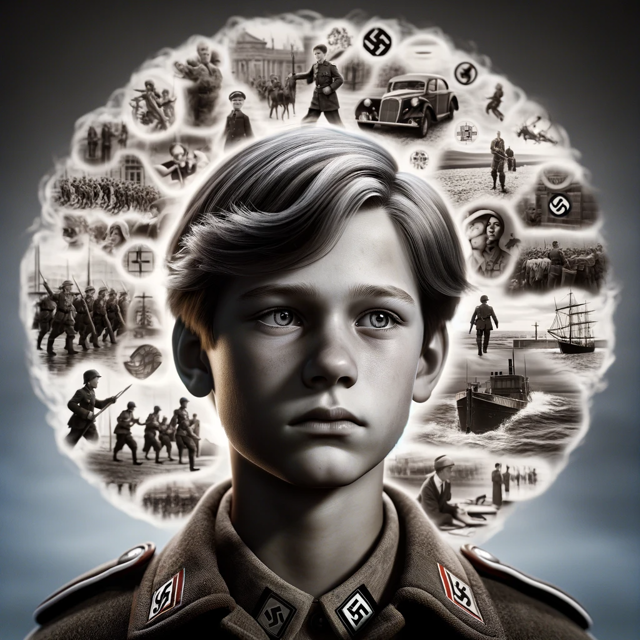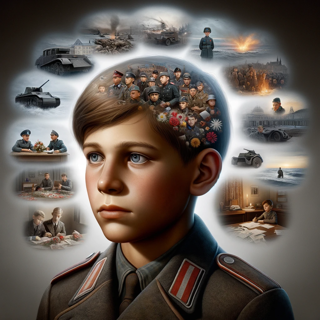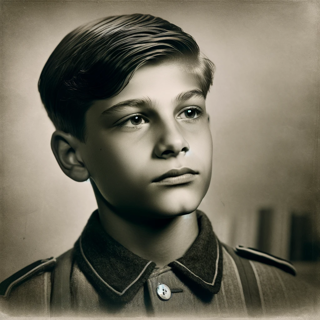January 2024
Unravel the gripping story of a young boy's journey through the Hitler Youth and the tumultuous path to 'denazification' in The Electrician and the Seamstress. This article delves deep into the indoctrination of Germany's youth, revealing the intricacies of how the Nazis manipulated a generation. Understand the profound impact this had on individuals and society, as seen through the eyes of Bruno's nephew, and explore the challenges of dismantling deeply ingrained ideologies post-war. This narrative is not just a historical account but a poignant reminder of the enduring effects of propaganda and the complexities of reeducation in a society emerging from the shadows of authoritarianism. Dive into this compelling read to comprehend the full scope of the Hitler Youth's influence and the painstaking efforts of denazification that followed.
Last updated 18 months ago
Will publish on 06/07/2026
Echoes of War: A Young German's Inner Struggle
By Monica Granlove

Bruno's nephew in the novel, The Electrician and The Seamstress was compelled into the Hitler Youth program, and after the war, he underwent the process of 'denazification.' This ongoing denazification was still in progress when Bruno returned almost two years after the war, having endured imprisonment in a Siberian camp and making his way home alone.
Established by Hitler in 1922, the Hitler Youth initially started as a 'club' for boys and girls. Its primary objective was to indoctrinate young minds with Nazi ideology, instilling unwavering loyalty to Hitler and the regime. This initiative, like many others, promoted cult-like behavior, and you can explore this further in the article "Beyond Belief: Understanding the Cult-like Dynamics in Politics and History"
The Hitler Youth provided a sense of belonging to young children, a crucial factor for individuals aged 10-18 as it significantly influences emotional, social, and cognitive development during adolescence. The Nazis understood that fostering a strong sense of belonging would enable them to manipulate young minds as the youth navigated the challenges of identity formation. The social bonds established within the Hitler Youth contributed to the unshakeable loyalty of the youth as they transitioned into adulthood.

By 1936, Hitler Youth membership became mandatory for all eligible German youth aged 10 to 18. The organization's influence on German youth was profound, offering a sense of camaraderie and purpose while subjecting them to intense ideological conditioning. As World War II approached, the Hitler Youth increasingly focused on military training, preparing its older members for future service in the armed forces.
The organization served a dual purpose beyond immersing youth in Nazi ideology—it also acted as a tool for the Gestapo to identify potential dissenters among adults. Whether knowingly or unknowingly, the youth became conduits for 'interviews' regarding the adults they encountered, scrutinizing any signs of dissenting behaviors. In the novel The Electrician and The Seamstress, Bruno and Karla found themselves at odds with the Nazis and their pervasive ideology. Surrounded by Nazis within their own family and community, their lives were fraught with emotional stress. Every minute of every day demanded careful consideration of their words, as the omnipresence of the Gestapo allowed for no due process. The constant fear of being reported created a tense atmosphere where expressing dissenting views could have had severe consequences.
After the war, the majority of Hitler Youth members underwent 'denazification.' This comprehensive initiative, led by the Allied forces, aimed to eliminate the remnants of Nazi ideology and dismantle structures supporting the Third Reich. Denazification involved various measures, such as removing Nazi officials from influential positions, dissolving Nazi organizations, and prohibiting Nazi symbols and propaganda.
Individuals associated with the Hitler Youth attended educational sessions that debunked Nazi propaganda and promoted democratic values. The militaristic aspects of the Hitler Youth were dismantled, and the organization disbanded, shifting the focus towards fostering democratic citizenship and discouraging blind obedience.
The effectiveness of denazification varied, with some individuals receptive to reeducation efforts, while others struggled to reconcile past beliefs with new democratic values. The Hitler Youth serves as a stark example of how authoritarian regimes exploit youth organizations to shape beliefs and behaviors. Understanding this history provides valuable insights into the broader context of Nazi Germany and the challenges of combating propaganda and indoctrination.
We could almost imagine a poignant narrative of a young German boy's struggle during World War II, we are reminded of the enduring impact of historical events on individual lives. His internal conflict, torn between the prevailing political ideologies and his innate sense of right, reflects a universal struggle that transcends time and place. It prompts us to question how far the shadows of history extend into the lives of ordinary people, shaping their beliefs, actions, and ultimately, their destinies.


